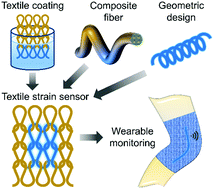Textile strain sensors: a review of the fabrication technologies, performance evaluation and applications
Abstract
The recent surge in using wearable personalized devices has made it increasingly important to have flexible textile-based sensor alternatives that can be comfortably worn and can sense a wide range of body strains. Typically fabricated from rigid materials such as metals or semiconductors, conventional strain sensors can only withstand small strains and result in bulky, inflexible, and hard-to-wear devices. Textile strain sensors offer a new generation of devices that combine strain sensing functionality with wearability and high stretchability. In this review, we discuss recent exciting advances in the fabrication, performance enhancement, and applications of wearable textile strain sensors. We describe conventional and novel approaches to achieve textile strain sensors such as coating, conducting elastomeric fiber spinning, wrapping, coiling, coaxial fiber processing, and knitting. We also discuss how important performance parameters such as electrical conductivity, mechanical properties, sensitivity, sensing range, and stability are influenced by fabrication strategies to illustrate their effects on the sensing mechanism of textile sensors. We summarize the potential applications of textile sensors in structural health monitoring, wearable body movement measurements, data gloves, and entertainment. Finally, we present the challenges and opportunities that exist to date in order to provide meaningful guidelines and directions for future research.



 Please wait while we load your content...
Please wait while we load your content...